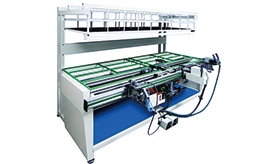Aluminium machine
Cutting MachineMilling MachinePunching and Drilling MachineCorner Crimping EquipmentProfile Bending MachineThermal Break Aluminum Profile LineMachining CenterAluminium Formwork Machine
Aluminium Formwork Cutting MachineAluminium Formwork Punching MachineAluminium Formwork Lacquering MachineSlot Milling MachineMiscellaneousFriction Stir Welding MachineAutomatic Multi-processing Aluminium Machinery
Hinge Making MachineSolar Panel Clamps/Cleats Making MachineAluminium Hardware Making MahcineOther Automatic MachinesuPVC window machine
Cutting MachineMilling MachineWelding MachineCorner Cleaning MachineBending MachineAuxiliary Machine
CBS Industry supply all kinds of auxiliary machine for upvc windows and doors fabrication to improve the productivity, i.e. reinforcement profile screw fastening machine, multi head installation holes drilling machine, hardware assembling machine, glass mounting table, profiles transportation trolley etc.



